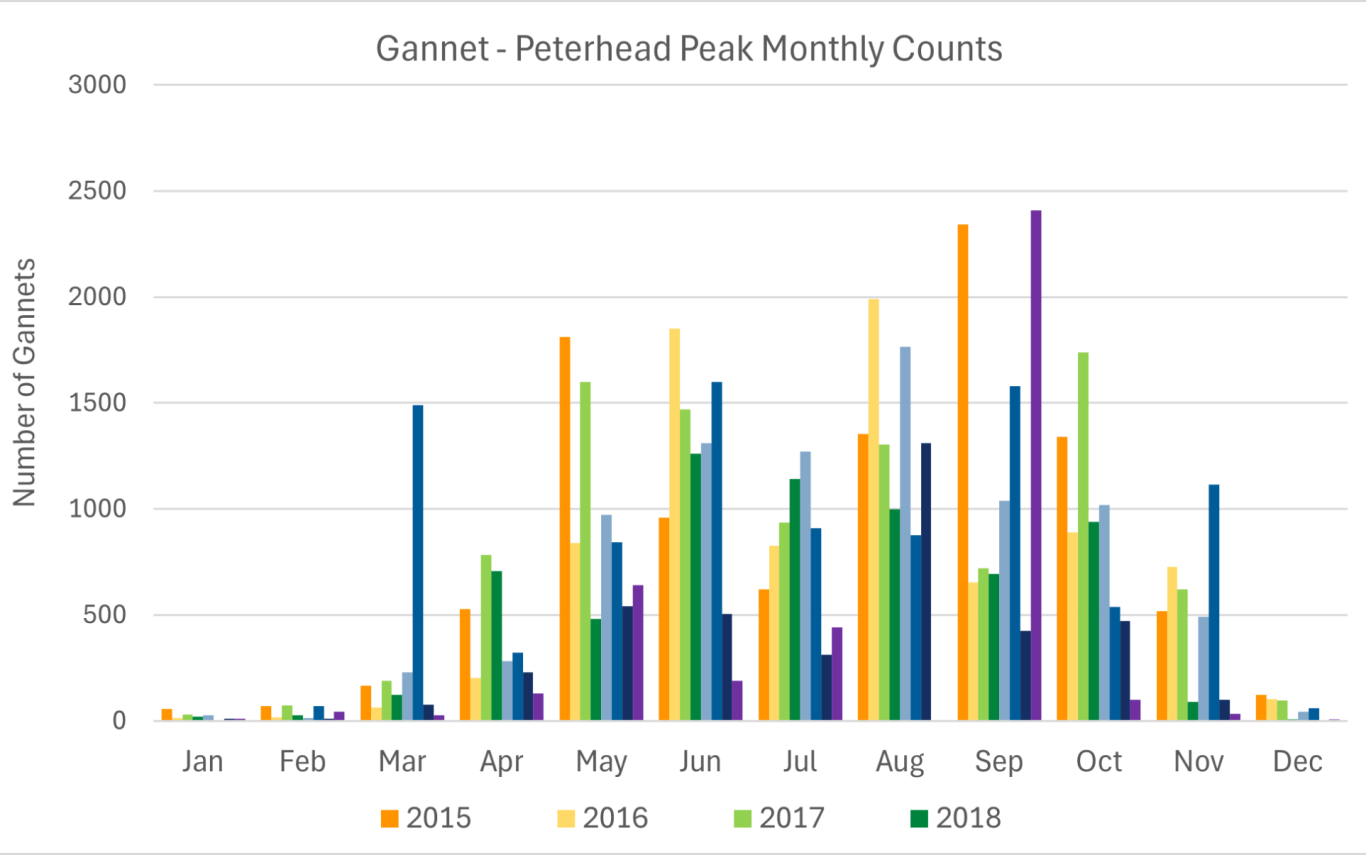Northern Gannet - Morus bassanus
Key Findings
Northern gannet (Morus bassanus) are a large seabird, with long pointed wings spanning up to two metres. Gannets begin with dark-grey brown juvenile plumage, lightly speckled white all over. Successive subadult plumage shows additional amounts of white until adult plumage is reached after five years: white all over with black wing-tips and a yellow tinged head (fig. 1). Gannets nest in colonies on cliff-ledges and slopes, with nests made of seaweed and other plant material (Svensson, 2020). They make impressive plunging dives into the sea from up to forty metres in the air, hunting for various fish such as sandeel, mackerel and herring.
Gannets generally reach breeding maturity around five years old, with a typical lifespan of seventeen years (BTO, 2023). Once adults, they have a high survival rate with mean annual adult survival estimated at 92% (Wanless et al, 2006).
Population & Distribution:
It is estimated that Britain, Ireland, the Isle of Man and Channel Islands together host 70% of the global breeding gannet population (Stanbury et al, 2024). Whilst there are no records of gannet breeding along the East coast, Scotland's only mainland breeding colony of gannets is located at Troup Head right around the corner along the Buchan coast. Because of this, the east coast is an important side for gannet movements and feeding. According to the North East Scotland Bird Reports, thousands move along the east coast every year. Records that submitted between 2015-2022, show gannets are seen in the area all year round with peak counts generally late summer (fig. 2).
Conservation Status:
Gannets are Amber listed in Britain, due to their breeding localisation and breeding importance to the global gannet population (Stanbury et al, 2021). The Troup Head breeding population is protected under the Gamrie & Pennan Coast SSSI (NatureScot, n.d.).
Avian Flu (HPAI - Highly Pathogenic Avian Influenza):
Avian flu has been devasting for the UKs seabirds, gannets in particular. A full colony count at Troup Head in 2019 found 4825 Apparently Occupied Nests (AON) with a productivity of 0.68 chicks per nest. In 2022, a plot count of 123 AON produced a productivity rate of 0.11 and this has been attributed to HPAI - an estimated 3000 adults died alongside 90% of chicks (NE Scotland Bird Reports). However gannets are potentially showing some immunity to HPAI in subsequent years, with survivors irises turned black (fig. 3) (Lane et al, 2024).
Other factors affecting northern gannets:
Gannets were on the increase in Scotland and to the east coast before avian flu. This has been attributed to a number of potential factors such as fisheries discards (before a ban on discards was implemented), high survival rates, adaptability and large ranges. Northern gannets are believed to be among the most vulnerable seabirds to collisions with offshore wind turbines, as well as disturbance from wind farms to feeding and flight patterns (Furness et al 2013; Peschko et al, 2021).
Gannets are impacted by factors similar to other seabird species such as fishing pressures reducing prey availability and fishing gear entanglement. Gannets appear to be most vulnerable to bycatch in offshore static net fisheries and longline fisheries (Northridge et al, 2020).
Report any sightings to BirdTrack, or NESBReC via the link below.

fig. 1: "Morus bassanus adu" by Andreas Trepte is licensed under CC BY-SA 2.5. To view a copy of this license, visit https://creativecommons.org/licenses/by-sa/2.5/?ref=openverse.

fig. 2: (NE Scotland Bird Reports) Peterhead Peak Monthy Counts of Gannets

fig. 3: (Rebecca James) - Gannet survivor of HPAI with full black iris in one eye
Notes
None
Linked Information Sheets
Key sources of Information
Furness et al (2013) Assessing vulnerability of marine bird populations to offshore wind farms
NatureScot (n.d.) Gamrie and Pennan Coast SSSI
NESBReC (n.d.) North East Scotland Biological Records Centre
North East Scotland Bird Reports, latest issue 2022 published Feb 2024
Stanbury et al (2021): The status of our bird populations
Stanbury et al (2024) The status of the UK’s breeding seabirds
Wanless et al (2006) Survival of gannets Morus bassanus in Britain and Ireland, 1959-2002
Reviewed on/by
Status
First draft
To report errors, highlight new data, or discuss alternative interpretations, please complete the form below and we will aim to respond to you within 28 days
Contact us
Telephone: 07971149117
E-mail: ian.hay@stateofthecoast.scot
We need your consent to load the translations
We use a third-party service to translate the website content that may collect data about your activity. Please review the details in the privacy policy and accept the service to view the translations.

